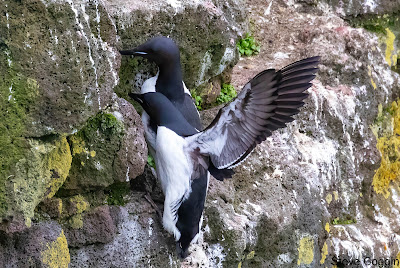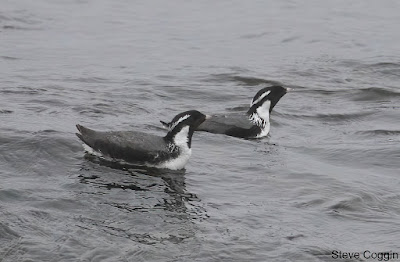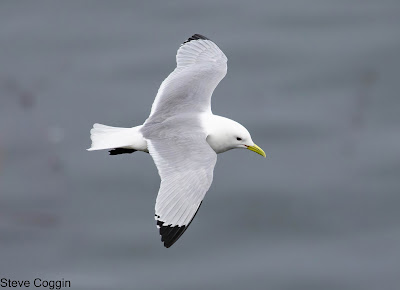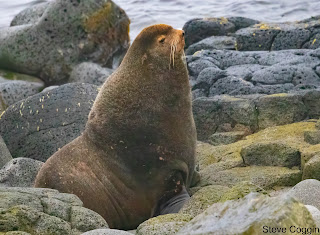 |
| Horned Puffin (Fratercula corniculata) perched on a lava cliff. St. Paul Island, Alaska, |
There is a small group of islands in the Bering Sea, 300 miles from the mainland of Alaska, called the Pribilofs. The islands of this archipelago are rimmed by cliffs and boulders and black sand beaches. The weather is often windy, cold, foggy, misty or rainy, and that’s in summer.
 |
| Last year's flower head of Puchki (Angelica lucida). Puchki is the largest native plant on the Pribilofs. St. Paul Island, Alaska. |
The islands are covered by tundra and the tallest native vegetation is the flowering stalks of Wild Celery, Puchki (Angelica lucida). But despite these conditions, the islands have an astonishing array of wildlife, from the world’s greatest largest concentration of Northern Fur Seals (Callorhinus ursinus) to sea birds nesting on the cliffs. Then there are the vagrant birds from Asia who get blown off course and use the islands to rest and feed for the few days then fly back to where they belong.
Diane, two friends and I visited St. Paul, the largest of the Pribilof islands for a week in June. We were hosted by St. Paul Island Tour. Their guides showed us the birds, mammals, plants, and the stark, stunning landscapes of this remote island.
 |
| Thick-billed Murres (Uria lomvia). St. Paul Island, Alaska. |
 |
| Thick-billed Murres. St. Paul Island, Alaska. |
The sea cliffs of St. Paul are the
nesting sites of many seabirds. The
Alcids (Family Alcidae) were well represented on the cliffs. These birds spend
most of their life at sea where they fly underwater using their wings to pursue
fish and other marine creatures. Alcids
only come to land to lay their eggs and raise their chicks. Many Alcids
resemble penguins with the black-and-white color pattern and upright posture. The
largest Alcids on the cliffs were the elegant black-and-white Thick-billed
Murres (Uria lomvia).
 |
| Tufted Puffins (Fratercula cirrhata). St. Paul Island, Alaska. |
 |
| Tufted Puffin. St. Paul Island, Alaska. |
Puffins are also in the Alcidae and two species, Tufted Puffins (Fratercula cirrhata) and Horned Puffins (Fratercula corniculata) were setting up nests on St. Paul. They were in full breeding plumage with large, brightly colored beaks. Tufted Puffins are black with a white face, bright orange beak and bold yellow tufts that sweep from behind the eyes and curl down the neck. Horned Puffins have black backs and wings, a white belly and face, a orange and yellow bill and a small black horn extending above the eye.
 |
| Horned Puffins. St. Paul Island, Alaska. |
Parakeet Auklets (Aethia psittacula), Least Auklets (Aethia pusilla) and Crested Auklets (Aethia cristatella) were also mating and building nests of the cliffs. These Alcids are smaller than the puffins but share the black-and-white color pattern.
 |
| Parakeet Auklet (Aethia psittacula). St. Paul Island, Alaska. |
 |
| Parakeet Auklet. St. Paul Island, Alaska. |
 |
| Least Auklets (Aethia pusilla). St. Paul Island, Alaska. |
 |
| Crested Auklets (Aethia cristatella). St. Paul Island, Alaska. |
Parakeet Auklets are black on the head and back, have a white belly, a fine white stripe behind the eye and an orange beak that landed them the parakeet name. Least Auklets are the smallest of the group. They have a black back, a white line running back from the eye and a mottled black-and-white belly. The most impressive species of the group is the Crested Auklet. They are black on the back, gray on the belly, have a white stripe running back from the eye, and a jaunty black plume curling over the orange beak.
 |
| Ancient Murrelets (Synthliboramphus antiquus). St. Paul Island, Alaska. |
 |
| Ancient Murrelet. St. Paul Island, Alaska. |
The Ancient Murrelet (Synthliboramphus antiquus) is another species of Alcid we saw on St. Paul. They have a black-and-white head, gray back and wings and a short beak. A pair of Ancient Murrelets were courting in the surf just off a beach and would even come ashore to perch on the kelp covered rocks.
 |
| Red-faced Cormorants (Urile urile) nesting on a cliff. St. Paul Island, Alaska. |
 |
| Red-faced Cormorant. St. Paul Island, Alaska. |
Red-faced Cormorants (Urile urile) are found across the Northern Pacific from Alaska, along the Aleutian chain to Russian Asia and Japan. They are iridescent black and during the breeding season have a bright red and blue patch of skin around the eye. Red-faced Cormorants swim underwater and catch fish with their hooked beaks.
 |
| Northern Fulmar (Fulmarus glacialis). St. Paul Island, Alaska. |
Another seabird on the cliffs of St. Paul is the Northern Fulmar (Fulmarus glacialis). This large bird looks like a gull, but it is more closely related to the petrels and shearwaters (Family Procellariidae). The Northern Fulmar is found in the Northern Atlantic and Pacific Oceans and feeds at sea on fish, shrimp, squid and other marine animals. Northern Fulmars come to land only to breed on sea cliffs where they raise a single chick.
 |
| Slaty-backed Gull (Larus schistisagus) (left) and Glaucous-winged Gulls (Laurs glaucescens) St. Paul Island, Alaska. |
St. Paul Island is the home to many gulls. The largest of these is the Glaucous-winged Gull (Larus glaucescens). It has a white head, breast and belly with a gray back and wings. Glaucous-winged Gulls have a yellow bill with a red spot and pink legs. The Slaty-backed Gull (Larus schistisagus) is native to Northwestern Asia, but a small population is resident in Western Alaska. One of these large, dark-backed gulls showed up at Salt Pond in St. Paul Village. The Slaty-backed Gull was resting on the mud flats with a group of Glaucous-winged Gulls where the size difference and wing color made it stand out.
 |
| Black-legged Kittiwake (Rissa tridactyla). St. Paul Island, Alaska. |
 |
| Red-legged Kittiwakes nesting (Rissa brevirostris). St. Paul Island, Alaska. |
The most interesting gulls were the kittiwakes. There are two species, the Black-legged Kittiwake (Rissa tridactyla) and the Red-legged Kittiwake (Rissa brevirostris) and both breed on St. Paul Island. Black-legged Kittiwakes are found around the Northern Atlantic and Pacific. Red-legged Kittiwakes are restricted to the North Pacific and most of the world’s population breeds on the Pribilofs. Both species of kittiwakes nest on the sea cliffs among the murres, puffins and auklets.
 |
| Male Northern Fur Seal (Callorhinus ursinus) on his territory. St. Paul Island, Alaska. |
 |
| Male Northern Fur Seal bellowing. St. Paul Island, Alaska. |
 |
| Young male Northern Fur Seals wrestling in the surf. St. Paul Island, Alaska. |
Over one million Northern Fur Seals, half the world’s population, arrive on the Pribilofs in early summer to breed. Males were hauling up on the beaches of St. Paul in June and setting up territories. The males fast the entire time they are on the beaches and lose about one third of their body weight. Females appear later, give birth, then mate within a week. The large males were bellowing and running off the young bachelors who trespassed on their territories.
The tundra and coasts of St. Paul
offered new discoveries every day. There
were so many remarkable things that another blog will be needed to recount them. Thanks to Sulli, David, Luis and Mariah of St.
Paul Island Tour for showing us these wonders.
No comments:
Post a Comment